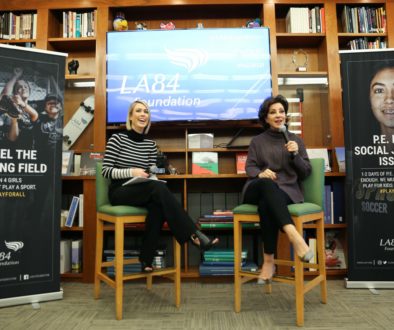SL Interview: Michael Sokolove Examines the Prevalence of Injuries in Girls’ Sports
A contributing writer at the New York Times Magazine, journalist Michael Sokolove is the author of “Ticket Out: Darryl Strawberry and the Boys of Crenshaw,” about the 1979 Crenshaw High School baseball team in Los Angeles, and “Hustle: The Myths, Life, and Lies of Pete Rose.”
Sokolove’s latest book, “Warrior Girls: Protecting Our Daughters Against the Injury Epidemic in Women’s Sports” (Simon & Schuster; Amazon) examines the culture of sports for young women. Sokolove applauds the fact that, since the passage of Title IX in 1972, the numbers of girls who participate in sports programs – at the high-school, club, and college levels – has increased dramatically. Writes Sokolove: “Athletic girls seem happier, more confident, more in control of their bodies and their destinies than girls who do not put themselves in motion, who do not compete, who do not experience all the highs and lows and disappointments and exultations than have long driven boys onto the field of play.”
His book, however, notes that there’s an “unforeseen and largely invisible consequence of the women’s sports revolution.” Writes Sokolove: “Girls suffer a whole range of injuries at greater rates than boys … The most serious problem, by far, is the routine incidence of major knee injuries in girls – mainly tears to the anterior cruciate ligament, or ACL … Girls tear their ACLs at rates as high as eight times that of boys.”
The book’s premise is not without its detractors. As Sokolove notes in the interview below, the Tucker Center Research for Research on Girls & Women in Sport, at the University of Minnesota, has drafted “a multidisciplinary response” to the book on its website. According to Nicole LaVoi, the associate director of the Tucker Center, “Framing the issue of sport injuries as an inevitable biological difference in the sex of the athlete is sensationalistic and irresponsible.”
SportsLetter spoke with Sokolove by phone from his home in Bethesda, Md.
— David Davis
SportsLetter: Why did you decide to write this book?
Michael Sokolove: I know that suffering a major injury in competitive athletics is always possible. But it seems to me that the level of injuries among mid-teen girls, playing for highly competitive club teams, is unacceptable. It isn’t just possible that if you’re an athlete you might be injured. It’s gotten very close to likely. And, people are running away from the issue because they don’t want to deal with it. But I think we do need to deal with it.
SL: You write that girls are different, physically, than boys and that that may contribute to the higher injury rate that girls suffer. What physiological factors are most significant regarding injury?
MS: A couple. One is just strength and muscle. When boys and girls go through puberty, the boys – even the laziest sloths among them – keep on getting stronger because of the influence of testosterone and the way boys’ bodies change. It’s really unfair: girls do not get appreciably stronger without putting some thought and some effort into it. But girls do get more flexible, especially in relation to boys. So, this combination of not enough strength and, sometimes, too much flexibility leaves the joints, and particularly the knees, at risk because girls don’t have enough good old-fashioned muscle to keep joints stable.
One other point that’s just as important: girls appear to run differently, de-accelerate differently, and land from jumps differently than boys do. They do so in a more upright, less flexed position. Not all girls, not all boys – but these are tendencies. They seem to have movement patterns that may leave them more vulnerable to certain injuries.
SL: Much of your book is an indictment of the youth programs that offer year-round instruction and competition in only one sport. What are the pros and cons of specializing in one sport at an early age?
MS: Well, I don’t think there are a lot of pros. Perhaps if you’re going to be world-class in certain individual sports – like tennis, golf, gymnastics – it may be necessary, although there are only a few Tiger Woodses out there. We don’t ever see or think about the ones who don’t make it to that level.
It’s very difficult, when a child is eight- or nine-years-old, to truly identify what someone’s “best” sport is. It’s destructive, in every way, to take away sports that boys and girls may be interested in. And, they are interested in other sports. Very few kids want to do the same thing, day after day, month after month, because it’s not fun. Playing different sports is what kids are what meant to do. But the culture of youth sports demands that they play one sport only.
There’s an assumption that specialization makes kids better at their sport, that it promotes mastery. But it doesn’t. Every expert will tell you that it absolutely doesn’t. So, it’s not about excellence; it’s about staying in a cohort. Here’s your team: it plays the fall season and the spring season; it does tournaments in the summer and it plays indoors in the winter. And, if you want to stay on this team, you have to do all those things. That’s not about becoming a better player; that’s about being allowed to stay in the cohort.
SL: How does specialization relate to overuse and/or overexposure injuries?
MS: With specialization, the danger is that kids use the same muscle groups, day in and day out, and this wears out the muscles. Cross-training used to occur naturally. We climbed trees, we waded streams, we rode bicycles. We played. We just didn’t call this “cross-training.”
The whole focus on specialization within the youth sports culture is really needed. I think what’s not being recognized is that everything that’s bad about a lot of youth culture, like specialization, is taking a greater toll on girls. Specialization is bad, and it’s worse for girls.
SL: How so?
MS: It’s not a good idea, for boys or for girls, to play one sport all-year round, five days a week. But I think we have to specifically tell girls: “Look, you’re not physically strong enough to keep up with this schedule.” They have to get stronger, if they want to compete in sports, because there are girls out there who aren’t the athletes they need to be for the schedules that they’re playing. They’re very, very skilled in their sport, but they’re not strong enough and they’re not moving in the right way.
That’s the bad news. The good news is, they can learn to train differently. They can go to the weight room and build up more of the right kind of muscle. Now, that gets very complicated because the weight room, to some extent, remains the domain of the football players and the boys.
SL: In one of your previous books, “Ticket Out,” you wrote about a pitcher at Granada Hills [High School] named John Elway, who turned out to be a pretty good quarterback. High-school athletes who play two sports, like Elway did, aren’t prevalent these days, are they?
MS: That’s really not allowed now. The culture doesn’t permit it. But I’ll say this: really good youth male athletes sometimes refuse to do just one sport. They’ll say they want to play baseball, too, and then do it. But my research tells me that a girl will more readily give up other sports. I think that correlates to what social-science research tells us: girls tend to be a little more agreeable in general. So, if you tell a girl, “You’re great at soccer, we want you to give up the other sports,” it tends to be a little easier to get them to do it.
I just read that one of Michael Phelps’ causes right now is to get more boys into swimming because, in U.S. swimming, it’s become so female-dominated. Now, swimming’s a sport that, to get anywhere in it, you have to give up all other sports. And I think that one of the reasons swimming is so female-heavy is that the boys just say no. They say, “I’m not giving up all these other sports,” at age nine or ten. The girls just say, “Okay.”
SL: You point out that the culture of girls’ sports has changed much since the passage of Title IX in 1972. What have been the pros and cons?
MS: There’s been this explosion in participation – which is wonderful – and I include my two daughters in that. Girls know that sports are as open to them as they are to boys, and that they get all these great benefits from sports. That’s the upside.
The downside is that, for lots of girls, sports have taken on this aspirational sense – which is that you don’t just play, but there’s always some team to be made, whether it’s the travel team or the ODP [Olympic Development Program] team. There’s always some carrot out there – either the college scholarship, which is almost always a fantasy although it fuels the tournament industry, or admission preference to colleges, which is much less of a fantasy. But I think these perceived rewards, which are so much a part of our sports culture, fuel a lot of overplay.
SL: You also write that, since the passage of Title IX, male coaches out number female coaches in girls’ sports. What’s been the effect of that?
MS: One of the things that happened when we decided that sports were really important for our girls – and they are – was that sports took on this centrality and this importance. And, when something’s important, we have to do two things: we have to spend money on it and we have to put experts in charge of it. In our culture, men are still considered to be the experts on sports.
Right after Title IX, there were lots of women coaches coaching women’s sports. In the beginning, it was pretty likely that if you were a girl, you were going to be coached by a woman. Now, the higher up a girl rises in her sport, beginning in her teens, the more likely it is that she’s going to be coached by a man. I think that’s unfortunate on lots of levels.
SL: What about the parents’ role in this? Have parents ceded the supervisory role of their children to coaches?
MK: I have two daughters. I have a daughter who’s already gone through college. She played a couple of different sports, although not at a super-high level. I have a 19-year-old daughter who’s a college sophomore and is a very good Division III swimmer. She’s been getting up [to swim] at 4:45 in the morning since age nine. So, I’ve lived this insane life myself.
In researching this book, I didn’t find a lot of stereotypical sports parents – the ones who push their kids and make them do things. I think there’s a misperception about that. I think it’s much more difficult to push your kid into high-level athletics than people think. Either your kid just quits or rebels. These sports take a high degree of dedication, and they’re just too hard for a parent to make a kid do it.
I found something different. I found that the kids – and the girls in this case – walked into this world, and it sort of snowballed on them. They certainly do love it, but as they rose up in levels, whole families get subsumed. Parents then do cede control to coaches. I find it surprising in a way because in our culture, more so than in the past, parents think nothing of walking into school and confronting teachers and principals and questioning the authority of teachers and principals. But the coach’s authority is rarely questioned.
Where I live and where a lot of this book is set – in suburbia and in upper- and middle-class communities – a lot of the better athletes have surpassed their parents’ athletic careers. So, I think that parents feel out of their league and are way too willing to allow the coach to set the agenda. That’s especially true in the club setting, because the club setting is where it happens now. Now, this coach may have no training in child development and is probably not an educator. And, to allow this person to set the kid’s schedule and priorities, I think that’s really a mistake.
SL: How does the trend toward club sports affect sports at schools?
MS: The school experience is often secondary now to the clubs. And, here’s the big difference. Schools set limits: the season starts on this day and it ends on this day. You’re allowed to play x number of games, and practices are allowed to be a certain length of time. One of the reasons that sports has gone over to the club level is because there are no limits. People feel that more is better. Well, guess what? More is not better.
SL: One of the central characters of the book is soccer player Amy Steadman and how strong-willed she is in undergoing five surgeries on her right knee before the age of 20. How did this “warrior mentality” come about and how does this contribute to the high injury rate?
MS: We empowered our girls, which is fantastic. We let them know that they’re capable of anything. Sports is a great way of letting a kid know that you should test yourself, that you shouldn’t be a quitter and stop at the first sign of discomfort. There are tens of thousands of warrior girls out there who are admirable and tough and determined. But they are more oft-injured.
In the book, I get into the military research on women being injured during basic training. The Army doesn’t really broadcast this, but women suffer more injuries during basic training [than men]. But they’re also more difficult to drive out of the service – in other words, men will leave with a lesser injury. That reinforces what athletic trainers and coaches told me repeatedly: it’s more difficult to get girls off the field. If a trainer says, “You need to rest because you’re hurt, you need to heal,” the girl is more apt to say, “Just wrap it up and let me go out there.”
I honestly don’t know all the reasons for that. I have suspicions. I think they’re deeply bonded with teammates and often deeply bonded with a coach. They’re less interested in personal glory and more interested in the community aspect of it. And so, maybe, they don’t want to leave their community, their team.
I also think that – and there’s no research to back this up but it’s based on my observations and dozens of interviews with female athletes – some of these girls have been playing in so much pain since age 11 or 12, that it’s normal to them. They don’t know what it’s like to play pain-free. They’re almost inured to pain. If they waited until they felt right, they’d never play.
SL: In profiling Amy Steadman, you also write about her college coach, Anson Dorrance at [the University of] North Carolina, and how hard he drives his players. How should we assess him: should we celebrate his winning record or decry the high injury rate that seems to afflict his players?
MS: I think that Anson Dorrance re-imagined and helped to re-invent the notion of what a female athlete is. His teams play fast, physical, aggressive soccer. There’s a lot to celebrate in that. There’s a trickle-down effect. If you want to compete with Anson, you have to play that kind of soccer. Everybody at the lower levels knows that that’s the game to play.
The more aggressively and faster any game is played, the more injuries are going to occur. So, if a mid-teenage girl plays Anson Dorrance-style soccer, and she plays it 11 months a year at all these tournaments, as opposed to a slower, more passive style of soccer, we’re probably going to see more injuries. I don’t think we have to toss out that kind of play; that kind of play is what most athletes want to participate in, girls and boys. But I think we need to face up to the fact that, if girls are going to play that way, then they need to train for it. And, number two, there’s no reason to play 100 games a year and five during a tournament weekend. I mean, there’s a mathematical component to this: the more you do it, the more likely you’ll get hurt.
SL: What were you more surprised at: the high injury rate or the fact that few people seem to be doing anything about it?
MS: I was surprised at the level of injuries. I was blown away when I ran across a soccer team of 18 girls that had a total of eight ACL injuries. I looked at the statistics and realized that, in a cohort of 20 girls playing club and high school soccer, over the course of four years, four of them are going to blow out their ACLs. It’s a terrible injury, and it’s unacceptable.
But I was also surprised that few people seem to be doing anything about it. Just now, the Tucker Center for Research on Girls & Women in Sport, at the University of Minnesota, created a blog for a “scholarly response” to my book. Five scholars responded, and four of the five cursorily dismissed the idea of the book. Interestingly, one of the scholars described herself as also a “soccer mom,” and she didn’t attack the book despite what seemed like an open invitation to do so. So, there’s this divide.
SL: You write that some women sports advocates have downplayed the high injury rate among girls. Why is this happening?
MS: I think they are the natural advocates because they care about girls and sports. They want them on the field and, I would think an extension of that would be, they want them on the field happy and getting all the great benefits of sports, and that doesn’t include suffering horrible injuries. But they’re not speaking out about it.
In my mind, the long-term advocates for Title IX and women’s sports clearly don’t want to deal with this issue because they feel that it suggests that girls are too delicate to play – or that some people will read it that way. Interestingly, they fear that the girls will be scared off the field. The girls I met were much too tough and determined to be scared off the field. I think what they want and need is information on how to play more safely and more research on how to prevent these injuries.
For this book, I talked to young female athletes. I talked to their parents. I talked to their coaches. I talked to orthopedics, I talked to a range of people all across the sciences. This was a three-year project. The only people who expressed caution to me and displeasure with what I was doing – and thought that this book could do some harm –were those whose lives are dedicated to the cause women’s athletics. I think they’ve done great work, and I admire them. But I think they’re really wrong
about this.
SL: What other responses have you gotten to the book?
MS: On my end, hundreds of emails and phone calls, lots of them from young women. The saddest ones are the ones that say, “I am Amy Steadman,” and then recount to me a series of injuries they had. Most of them say, “I wish I had known some of this. I wish I had known there were some things that maybe I could’ve done.”
I’ve gotten lots and lots of emails from younger athletes and from parents of younger athletes, most of them thanking me and asking me where they could get more information. A lot of people want to know what to do.
SL: What do you tell them?
MS: I tell people that they have to find some training program, from a certified athletic trainer or a physical therapist who’s knowledgeable about gender-specific issues and knows how to train around them and how to protect the athlete. I tell them that, and I tell people to band together as parents. You pay your kids’ club fees. You pay your kids’ coach. You run the show. Demand a sane schedule. Don’t allow back-to-back tournaments, these crucibles where they play five games in three days. Just say no.
SL: You identify PEP (Prevent Injury and Enhance Performance) as a preventive exercise program. Can PEP prevent knee injuries for young women?
MS: Their research indicates some really promising results. What I like about what they do is, it’s something that they can take out to the field. It’s a prevention program that replaces a normal warm-up. I don’t know that the PEP program is the ultimate answer. I think it’s promising.
Right now, the research is on-going and there’s nothing definitive. I think that anything anybody does – whether you persuade your coach to institute a PEP program or whether you adapt it in some way that works for you as a team or whether you find some private training with a certified athletic trainer or physical therapist – any attention that’s given to this by someone who’s an expert in the field helps the athlete. And that starts by the trainer or therapist saying, “Okay, this is a female athlete in front of me. Here’s how I’m going to train her to help protect her knees and get her to run in a different way and get her a little stronger.” Does that mean she’s never going to suffer an ACL injury or some other injury? No, but I think you can make some strides just by turning attention to this issue and giving it thought and implementing thoughtful training. And, I think PEP’s a pretty good place to start.
SL: Was there any subject that you would have liked to spend more time on in the book?
MS: The issue of concussions among girls. Anson Dorrance said to me that he worries more about the concussions than the ACLs. He felt that the concussions did come from more aggressive play. There’s a growing and relatively new body of knowledge about concussions – a growing awareness that we don’t understand them very well, but that they’ve got longer-lasting effects than perhaps we realize, especially for teenagers. And, there seems to be some gender differences. Clearly, it takes less force to cause a concussion in a female athlete, generally speaking, because their necks are weaker and their heads are smaller.
I was shocked that the concussion rate of an NCAA women’s soccer player is roughly the same as an NCAA football player. That shocked me, because there’s an enormous amount of attention given, and an enormous amount of money spent, to lessen concussion rates in football. Obviously, football’s got a real problem, because the game breeds concussions. It’s a collision sport.
SL: What’s your next book project?
MS: I don’t have another book project right now. I’m concentrating on writing magazine stories for the New York Times Magazine and looking for my next book project.




